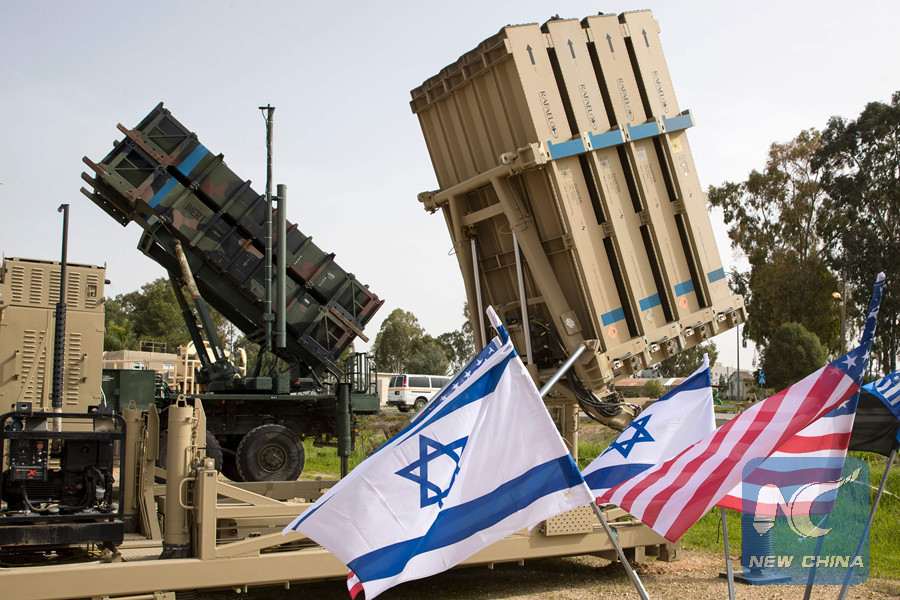
An Israeli "Iron Dome" anti-rocket system (R) and an U.S. "Patriot" missile defence system (L) are exposed during a joint Israeli-U.S. military exercise "Juniper Cobra" at the Hatzor Airforce Base on March 8, 2018. (AFP photo)
JERUSALEM, March 9 (Xinhua) -- Nearly 5,000 Israeli and U.S. soldiers have been training shoulder to shoulder since Sunday for a simulated missile attack on Israel.
The military exercise, dubbed "Juniper Cobra 18," is a biennial event that has been held nine times since 2001 by the Israeli military and the U.S. European Command (USEUCOM).
It is being conducted mostly in the Hatzor Air Force base in southern Israel.
"We will train and practice together, shoulder to shoulder, the same as we will fight in real time," said Brig. Gen. Zvika Haimovich, chief of the Israeli Air Defense Command.
For Israel, the threat of missiles is constant. In every recent conflict, Israeli cities and citizens were targeted by a range of rockets.
Hezbollah, a militant organization based in Lebanon which borders Israel to the south, is believed to possess more than 100,000 missiles that have the ability to strike anywhere in the Jewish state.
Israeli defense officials believe the missiles to be used in the next conflict will be more precise than ever before.
In the last war between Hezbollah and Israel in 2006, over 4,000 rockets were fired by the militant organization in the month-long armed conflict.
In Israel's southern border, the militant Hamas organization which controls the Gaza Strip also poses a huge threat by its thousands of rockets with various ranges.
During the 2014 war on Gaza, missiles fired into Israel reached central cities at a high frequency unknown before.
Last month, an Israeli air defense system shot down an Iranian drone which entered its airspace from Syria.
For years, the Jewish state has thus made missile air defense a priority, with billions of U.S. dollars being spent on research and development of interception systems.
With U.S. funding and support, the country has developed several systems such as the Arrow, Iron Dome, Patriot and David's Sling, all of which are being used in the drill together with American systems.
David's Sling is meant to target medium and long-range missiles. It has been operational for almost a year but is used in the drill for the first time.
"We will practice very complex scenarios that are very relevant in this dynamic environment we are part of. It will be a multi-directional threat, from south, north and east," said Haimovich.
On top of the list of possible war scenarios in Israel is a massive ballistic missile attack coming simultaneously from more than one border.
The drill is a display of the multi-layered defense mechanism in place, while officers at the drill did not mention a specific threat.
"We need to be ready for all the spectrum," Haimovich told reporters. "The other side will use salvos, more accurate rockets and it will be a multi-directional threat. Those are our assumptions."
"It will be a difficult mission that requires a precise, integrated effort," said U.S. Air Force Commander Lt. Gen. Richard M. Clark, the senior American officer at the Juniper Cobra 18 exercise.
Coordination is key, not only between the forces, but also the systems. The choice on which system to use against which threat needs to be made in seconds.
During the drill, participating U.S.-Israeli forces will deploy various available air defense systems. They also conduct computer simulations.
For U.S. Army Maj. Mary Thornton, it is the third time she has been taking part in the drill.
"The U.S. military is here working on our partnership. We are training together for readiness operations and making sure that we are prepared in case we get the call to continue and support our Israeli air defense forces," Thornton told Xinhua.
During the Gulf War in 1991, the U.S. deployed then new Patriot missile defense battery on Israeli shores when the country became the target of Iraqi scud missiles, a testament to a deep partnership between the two countries despite not a huge success.
"There's no question about the commitment. We're here right now driven by that commitment and we'll continue to be driven by that commitment for the foreseeable future," said U.S. Lt. Gen. Richard M. Clark.
Clark told reporters that American troops would be ready to deploy "fighting forces" to Israel within 72 hours in the event of a war.
The drill, expected to last until the end of the month, will conclude with a live-fire exercise using both American and Israeli air defense systems.

